Croatia All Year Long: Where To Travel Each Month
Images of sun-drenched islands and turquoise bays are enough to entice anyone to the shores of the Adriatic, but if you think Croatia is only a summer destination, think again! Don’t subscribe to the common misconception that this beautiful, multi-faceted country is only a warm weather destination. Croatia has so much to offer all year round!
So, what’s the best time of year to visit Croatia? Any time, so long as you know where to go.
True, many destinations will offer a wonderful experience for visitors just about every month, but only those in the know can suggest when to visit for the ideal environment; a combination of perfect weather, unique cultural events, and the pleasurable atmosphere of traveling sans crowds.
But fear not, Tasteful Croatian Journeys has got you covered with our guide to the best places to visit every month of the year.
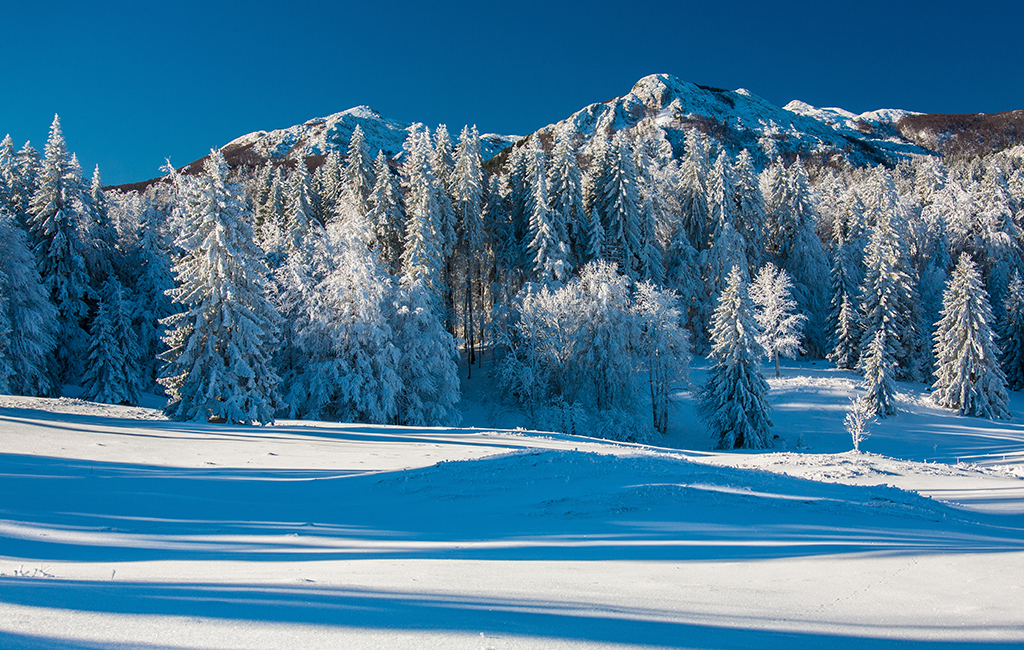
January: Gorski Kotar
Where the Alps Meet the Mediterranean
Swimming, snorkeling, sailing… skiing?
It may seem like one of those items doesn’t belong, but all are possible in the small yet geographically diverse country of Croatia.
Located in Croatia’s northwest, between the Kvarner Gulf and the Slovenian border, is the mountainous and heavily forested region of Gorski Kotar. Here you will find dramatic peaks, lush river valleys, underground caves, craggy karst terrain, and tranquil lakes. Nicknamed “Croatian Switzerland,” it is perhaps not surprising that in winter this region becomes a popular ski destination for locals. In fact, one of the region’s highest peaks, Snježnik, located in Risnjak National Park, was even named for the snow that remains on its slopes well into spring.
The best known and largest of the ski resorts in the region is the Croatian Olympic Centre Bjelolasica, which served as a training base for the 1984 Sarajevo Winter Olympics when Croatia was still a part of Yugoslavia. This is where four-time Olympic gold medalist, Janica Kostelić, first began her skiing career, and it continues to attract ski enthusiasts today. There are several small ski resorts throughout the region which offer Alpine and Nordic ski trails, and even small ski jumps. Other winter sports such as snowboarding, tobogganing, and snowmobiling are also popular leisure activities.
And yes, it’s true, Croatian ski resorts might lack the glamour and polish of world-famous locales like St. Moritz or Courchevel; but tell us, can you see the sea from Kitzbühel? The Croatian resort of Platak is located less than 20 miles from the coast and boasts magnificent views of the Adriatic Sea as well as the islands of Krk, Cres, and Lošinj. It is one of few places in the world where you can go skiing in the morning and walk along the sea in the afternoon!
Read more about Risnjak National Park in the region of Gorski Kotar here.
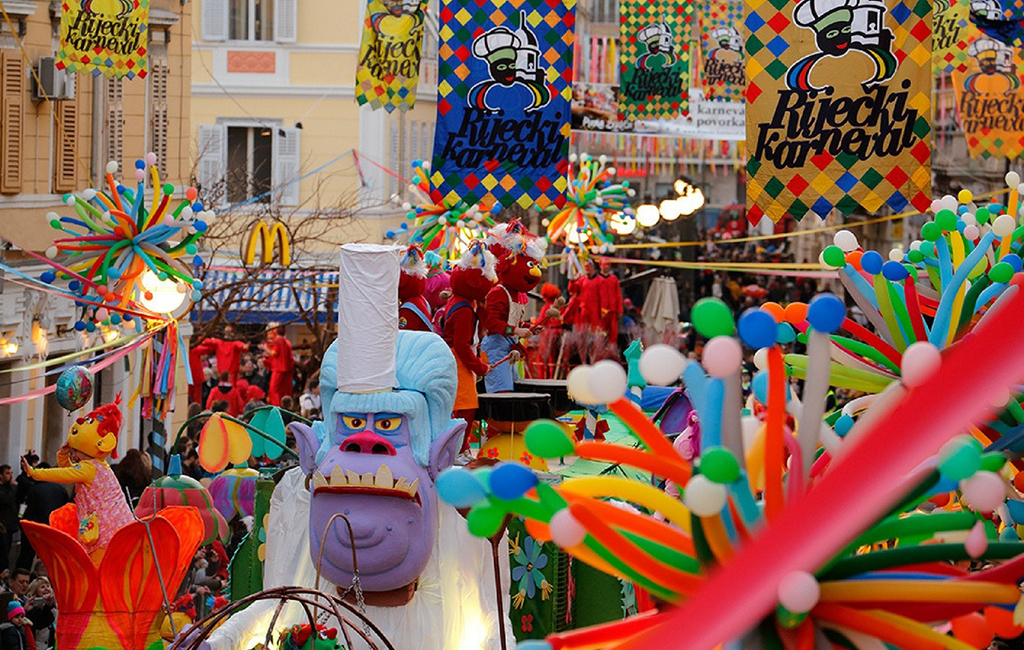
February: Rijeka
Carnival Revelry on the Kvarner Coast
Picture this: More than 100,000 eager spectators line the street in anxious anticipation. In the distance, whistles blow and bells clatter; the sound of music draws nearer and with it the crowd’s excitement grows. A burst of color comes into view – hundreds of elaborate floats, on top of and around which dance thousands of flamboyantly costumed performers, consuming the promenade in a rollicking uproar!
Is it Carnival in Rio de Janeiro? Mardi Gras in New Orleans?
Guess again; this vibrant scene is Karneval in the Croatian city of Rijeka!
Situated in the north of Croatia on the Kvarner Gulf, Rijeka is Croatia’s third largest city; a bustling coastal center blending the grandeur of Venetian and Austro-Hungarian pedigree with the industrial grit of a shipbuilding port. A cultural melting pot and artistic bastion, is it any surprise that Rijeka plays host to one of Europe’s biggest street parties?
Rijeka Carnival (Riječki Karneval) has been steadily growing in size since first organized by the local tourist board in 1982. What began with just three masked groups reviving an ancient custom, has since grown into a celebration of epic proportions, earning Rijeka a place in the Federation of European Carnival Cities.
Carnival season, also referred to as the “fifth season,” is a pre-Lenten celebration which follows the Christian liturgical calendar, but originally began as a pagan ritual to cast out winter. Festivities typically kick off around the Feast of St. Anthony and end on Ash Wednesday (usually late January – early February). The revelry officially begins when the mayor of Rijeka passes the key to the city to the Carnival Master of Ceremonies, a symbolic gesture ushering in several weeks of costumed fun, including a pageant for carnival queen, a Charity Masquerade Ball, and several parades, culminating in the raucous International Carnival Parade which takes place annually on the Sunday before Shrove Tuesday. The International Carnival Parade is the single largest one-day event anywhere in Croatia.
However, Carnival isn’t Rijeka’s only claim to fame. In 2020, the city received international attention when it was named Europe’s Capital of Culture. Unfortunately, the program of theater, concerts, dance, art exhibits, and other activities was reduced due to the Covid-19 pandemic. Nevertheless, with so much to offer curious travelers, anyone would agree that Rijeka has a bright future ahead.
Read more about Carnival in Rijeka here.
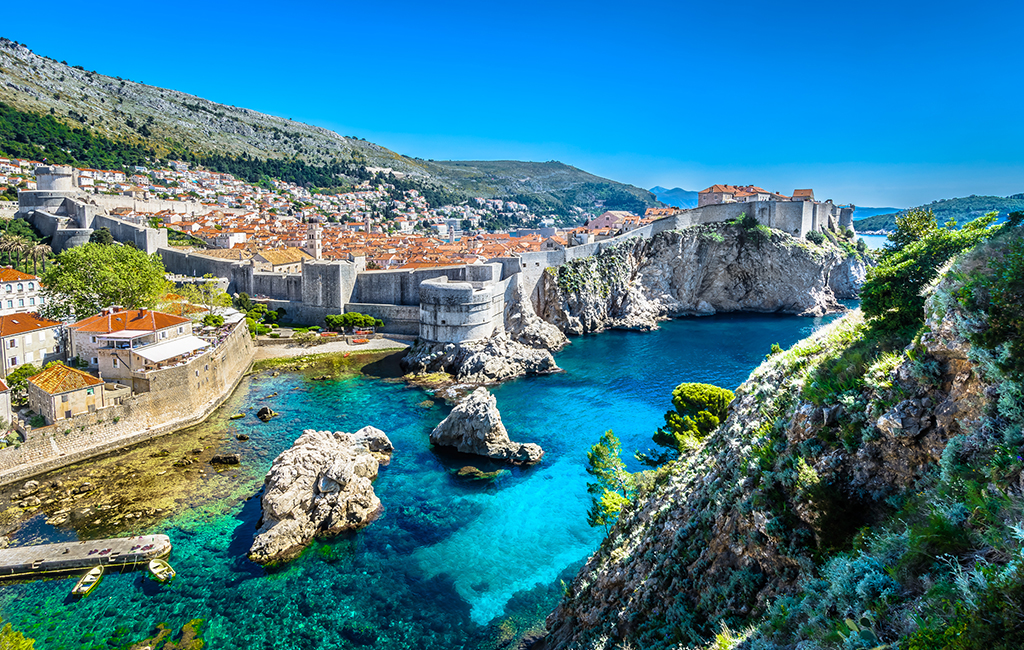
March: Dubrovnik & the Pelješac Peninsula
Succulent Oysters Near the Adriatic’s Pearl
Let’s be honest, there’s no bad time to visit Dubrovnik! The “Pearl of the Adriatic” is perfection all year long.
Occupying a rocky promontory, encircled by imposing defensive walls, Dubrovnik’s UNESCO protected Old Town is a pedestrian-only web of limestone streets and hidden alleys home to numerous architectural treasures. Stunning examples of Gothic, Renaissance, and Baroque churches, monasteries, palaces, and fountains anoint Dubrovnik with a beauty and historical richness that few other cities can rival.
However, having gained worldwide recognition as the home of King’s Landing in HBO’s Game of Thrones, it’s not exactly “under the radar” of modern travelers. So, to experience the city as the locals do, we recommend visiting off season. Yes, it’s true that in March you won’t be needing your swimsuit, but you will be able to enjoy a quieter side of the city that few others ever see. In addition to benefitting from fewer crowds and favorable hotel rates, March’s mild temperatures provide the ideal conditions for exploring Dubrovnik’s Old Town, including the fortification walls that surround the city. At more than a mile long, and offering little shade, walking the city’s walls can be an intimidating task during summer, but at the start of spring, a late morning stroll is the ideal way to take in the spectacular views over Dubrovnik’s titian rooftops and the Adriatic beyond.
Just an hour away, the Pelješac Peninsula stretches out north into the Adriatic. One of Croatia’s top wine producing regions, it beckons visitors to indulge in its robust, earthy reds and crisp, dry whites. At the base of the peninsula, the twin villages of Ston and Mali Ston form what was once the northwestern border of Ragusa, the independent republic that eventually became Dubrovnik. Here, extensive fortification walls – among the longest in the world after the Great Wall of China – protect Europe’s oldest salt flats and the “white gold” of the ancient economy. However, of all the many delights to be found in Pelješac, the region is perhaps most famous for its world-class oyster production. The unique and distinctive properties of the Mali Ston Bay, the salt from the sea combined with the mineral rich freshwater discharge from the Neretva river, create the perfect environment for plump, briny oysters.
Although Ston’s oysters can be sampled at any time of year, true seafood lovers will want to plan their trip to coincide with the annual “Festival of Oysters” which takes place in late March and doubles as a celebration of the Feast of St. Joseph. It’s the perfect opportunity to sample the famed mollusks paired with quality local wines. In addition, the celebration promises two days of Dalmatian music and folklore performances – a treat for locals and visitors alike!
Learn more about all there is to see and do in Dubrovnik here.
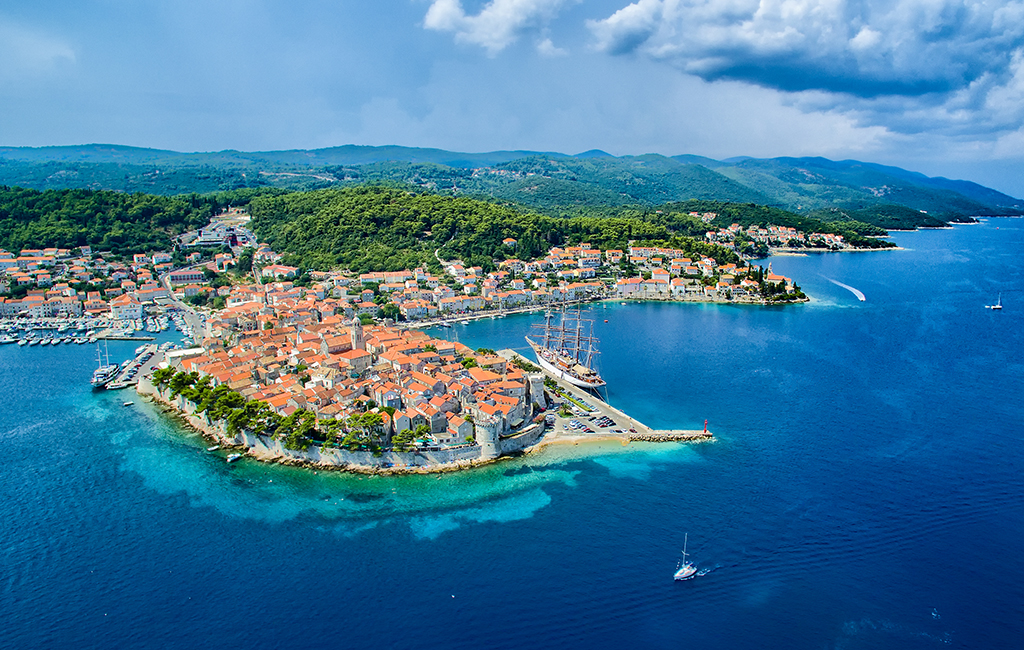
April: The Island of Korcula
See Ancient Traditions Spring to Life
As spring brings warmer temperatures and sunnier days, it’s not only the flowers in Korcula that begin to bloom, but the island itself! With nature’s rebirth also comes the official start of the tourism season. Hotels and restaurants shuttered for winter re-open and locals who leave the island during colder months return.
Pleasant, mild weather ushers in a season of festivals, starting with the annual Easter Processions. This centuries-old tradition centers around Korcula’s three religious brotherhoods; the Brotherhood of All Saints (the oldest, dating back to 1301), the Fraternity of St Rocco (established in 1575) and the Brotherhood of the Blessed Virgin of Consolation (also known as St. Michael, dating back to 1603). All catholic families of Korcula belong to one of these three fraternities, although participation in liturgical rites is reserved exclusively for the men and passed down from generation to generation. During the Holy Week leading up to Easter Sunday, the brotherhoods take part in solemn processions through Korcula’s medieval Old Town, carrying banners, crosses, and massive torci (candles), many of which are hundreds of years old, a few meters high, and extremely heavy. Even for those who are not religious, the atmosphere of the processions can be a moving experience, as hundreds gather to move through the town in the dim of night, singing psalms by light of candle.
Later in the month, Korcula’s annual triathlon, the Marco Polo Challenge, attracts athletes from far and wide to swim, cycle, and run through the island’s idyllic surroundings. Beginning and ending in the Korcula Town Center, the course traverses the entire island, winding through charming villages and skirting the rocky coast. The event, named for the island’s most famous resident, was launched in 2011 and normally includes a Middle-distance triathlon, a Sprint length triathlon, a team relay, and a street race.
If you’re lucky, the Korculanske Pjatance Spring Food and Wine Festival may also be on, as it takes place in either late April or early May every year. This gourmet food festival celebrates local Dalmatian flavors as some of Korcula’s finest restaurants come together to offer special menus, cooking demonstrations, and workshops. Foodies won’t want to miss it!
Learn more about all there is to see and do on the Island of Korcula here.
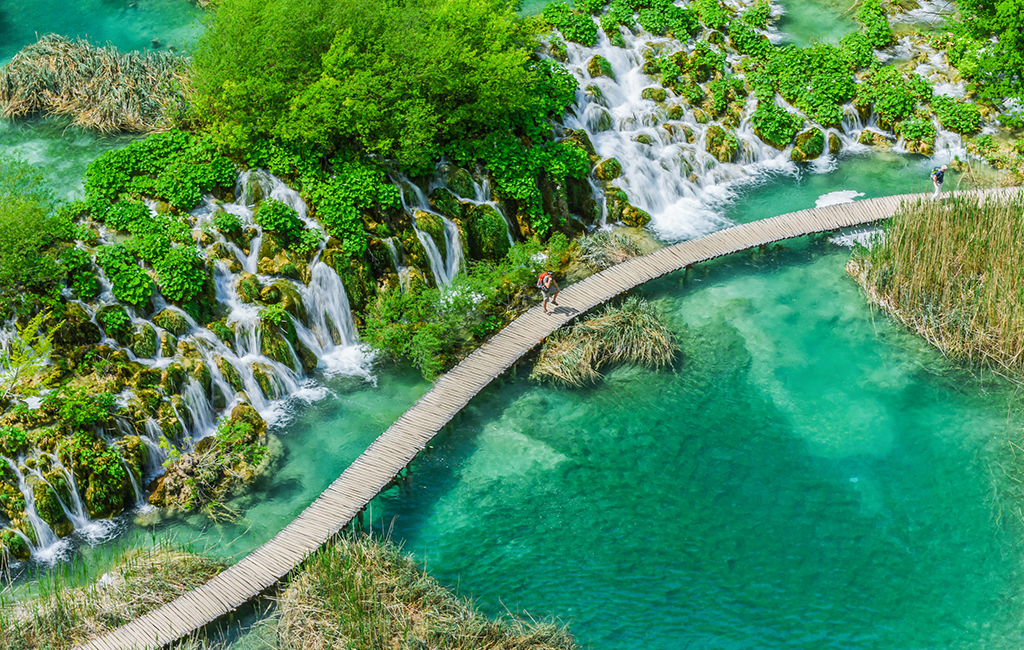
May: Plitvice Lakes National Park
Chasing Waterfalls in Croatia’s Most Beautiful National Park
Croatia’s most famous national park is a kaleidoscope of colors throughout the year, with turquoise cascades adjacent stark white snow in winter and deep umber leaves in autumn, but it is the budding emerald green of spring that it is at its most vibrant. As the weather warms, Plitvice’s flora awakens in a burst of green, nourished from the wet winter months and restored by the life-giving rays of the sun.
Visit in May to take advantage of sunny weather and pleasant temperatures without the crowds of peak season.
Sitting comfortably in the middle of the spectrum, May is neither the hottest nor coldest, wettest nor driest month of the year. Visitors can expect warm weather, comfortable humidity levels, and days that grow increasingly longer throughout the month; ideal conditions for a jaunt through the lush greenery of Croatia’s premier natural attraction.
The park’s 16 terraced lakes and the cascades and waterfalls which connect them have been divided into two sections, the Upper Lakes and the Lower Lakes. Anyone who is familiar with images of Plitvice Lakes will surely recognize the Lower Lakes, as many of the park’s most iconic features can be found here. Conveniently, and much to the delight of day-trippers, the Lower Lakes also lend themselves well to a single day of exploration. It takes just 3 to 4 hours to cover this section of the park. Zagreb and Zadar both make ideal home bases for those interested in a full day excursion.
Travelers with more time will want to plan on spending a few days to take full advantage of all that Plitvice Lakes and its surroundings have to offer. Granted UNESCO World Heritage status in 1979, Plitvice Lakes is Croatia’s oldest and largest national park – nearly 5 times the size of the next biggest national park! It’s also by far the most visited park, welcoming close to 1.8 million visitors each year. Extending your stay for several days will allow time to explore both the Upper and Lower Lakes, as well as the vast network of forest trails which skirt the perimeter.
Learn more in our first-timer’s guide to Plitvice Lakes National Park here.
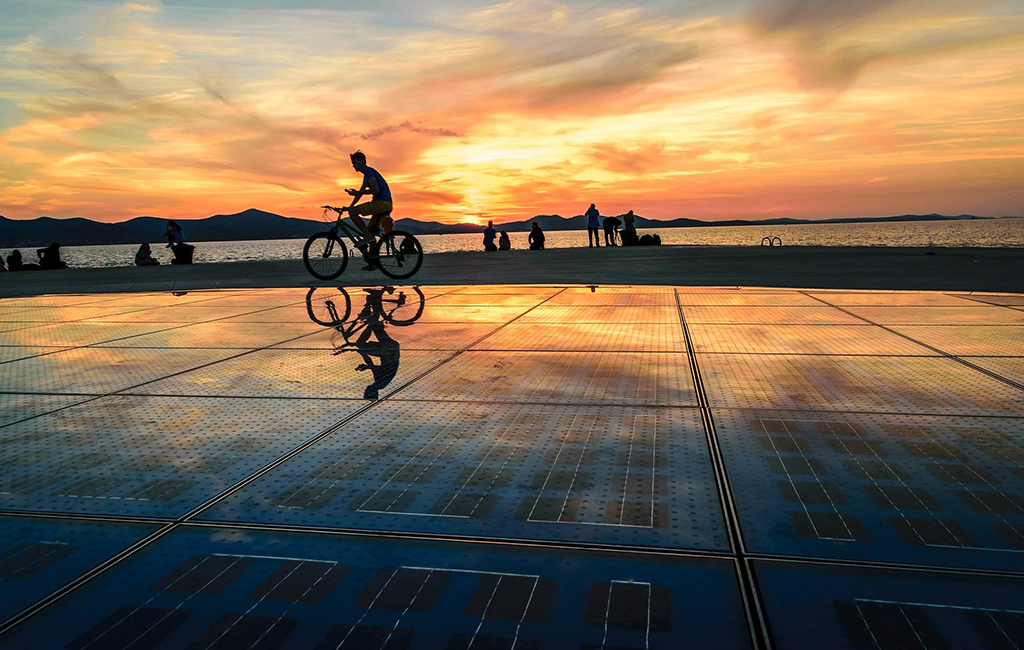
June: Zadar & the Kornati Islands
Celestial Beauty Right Here on Earth
In 2019, Zadar received a coveted position on the New York Times’ 52 Places to Go list, heralded as a seaside gem often overlooked by travelers as they make their way south toward Dubrovnik. From that moment on, the secret was out – Zadar is not to be missed!
This compact coastal city is full of surprises. The historic center is small enough to see in a single morning, yet offers enough art, history, and culture to be explored for days. The oldest continuously inhabited city in Croatia, Zadar is home to prominent examples of Roman, Byzantine, and Venetian architecture, including the city’s UNESCO listed fortification walls. This elaborate defensive system, once used to fend off Ottoman attacks, now serves as a series of scenic promenades and parks. It’s just one way that Zadar seamlessly blends old and new.
Be sure to enjoy a walk along Zadar’s beautifully landscaped Riva, the waterfront path on the edge of the Old Town peninsula. Here you will find two of the city’s most unique attractions – the Sea Organ and Greeting to the Sun – public artworks created by Croatian architect Nikola Bašić. Since 2005, the Sea Organ has mesmerized visitors with its elysian melodies. Reminiscent of a whale call, the hypnotic sounds are created by a series of pipes and whistles set within wide, stone steps that descend into the sea. The ebb and flow of the sea’s current forces air through the pipes, resulting in a constantly changing harmony. Just a few steps away, another one of Bašić’s installations, Greeting to the Sun (also referred to as the Sun Salutation), pays homage to the sky above. Composed of hundreds of solar panels embedded into the ground, the piece absorbs energy during the day and at night releases it in the form of colorful light beams that dance in unison with the sounds of the Sea Organ.
It’s the perfect place to watch Zadar’s famed sunset…
And the perfect time to watch Zadar’s famed sunset is June, when the shallow angle of the setting sun promises a longer duration for near solstice sunsets.
If you weren’t already packing your bags for Zadar, we have one more reason for you to visit!
Zadar is also the perfect jumping off point from which to visit a number of Croatia’s lesser-known islands, including the ethereal moonscapes of the Kornati. This tranquil archipelago is made up of 140 islands and islets, 89 of which are part of Kornati National Park. Scarcely populated and strikingly beautiful, Nobel laureate George Bernard Shaw said it best when he stated, “On the last day of Creation, God wanted to crown his work and thus he created Kornati from tears, stars and breath.”
Learn more about the Kornati Islands here.
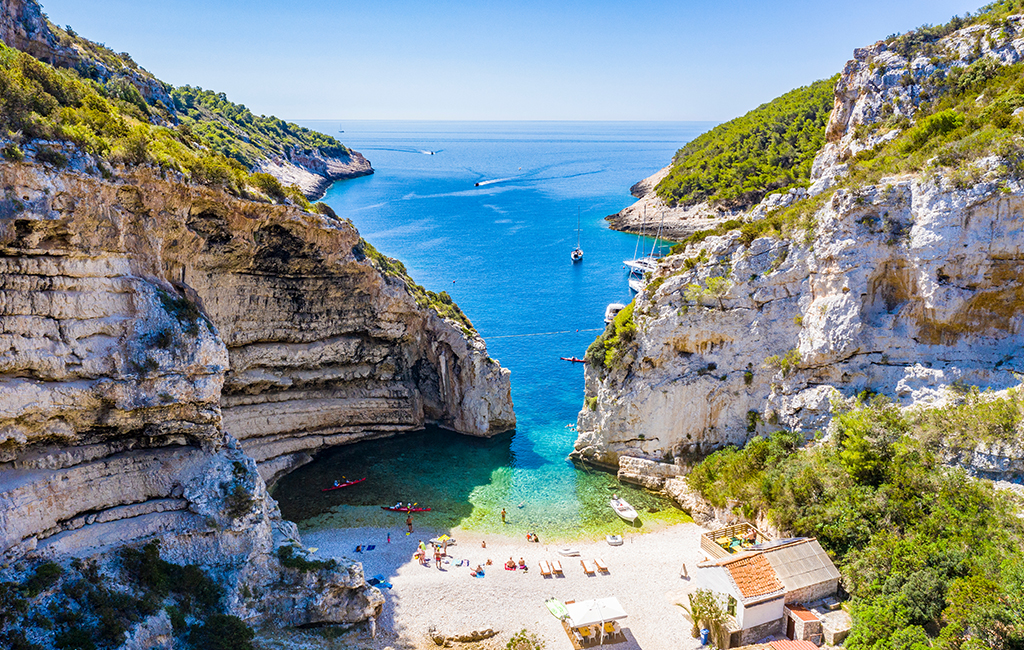
July: The Island of Vis
A Tranquil Island Hideout
Did you know that close to half of all tourism in Croatia takes place in July and August alone? In fact, in each of those months, Croatia welcomes roughly as many visitors as it has residents!
Avoid the throngs of tourists with a visit to Central Dalmatia’s most remote island, the unspoiled paradise of Vis. Lying roughly 30 miles off the Croatian mainland, Vis has a unique history which has helped preserve its authenticity and protect it from over development. Having served first as a hideout for Tito and his Partisans during World War II and later as a Yugoslav military base, Vis was completely cut off from visitors for close to fifty years. This prolonged period of isolation came to an end in 1989 when the island was finally open to outsiders. Since then, it has attracted in-the-know travelers seeking simplicity, undisturbed nature, local flavors, peace, and quiet.
Vis gained international attention when the blockbuster “Mamma Mia, Here We Go Again,” was filmed there. However, despite increased interest, the island retains its rustic charm. Pine trees, carob trees, wild rosemary, and citrus orchards cover the island, interrupted only by sprawling vineyards or ancient stone villages. Along the shore, rocky cliffs open up to reveal white pebbled beaches, while out at sea, fishermen haul their treasured bounty back to the island’s many konobas. A petite 35 square miles, Vis is easily explored by bike or scooter. The driving distance between the island’s two main towns, Vis Town and Komiža, is a mere 13 minutes by car. Indeed, the island’s intimate size only adds to its appeal – although easy to explore in a relatively short time, it rewards its visitors with new discoveries at every turn.
Most of those who visit Vis come only for a day excursion to see the Blue Cave; a shame as they will miss the tranquility which makes the island so special. Located on the tiny island of Biševo just southwest of Vis, the Blue Cave is a limestone cavern accessible only by sea which, when illuminated by the sun’s reflection off the shallow seabed, gives the impression of being a brilliant blue. Though a stunning sight, do not make the mistake of overlooking the island’s other charms. Like its wine and seafood, a visit to Vis should be savored over time.
Vis is renowned for the quality of its seafood. Read about some of our favorite seafood restaurants in Vis here.
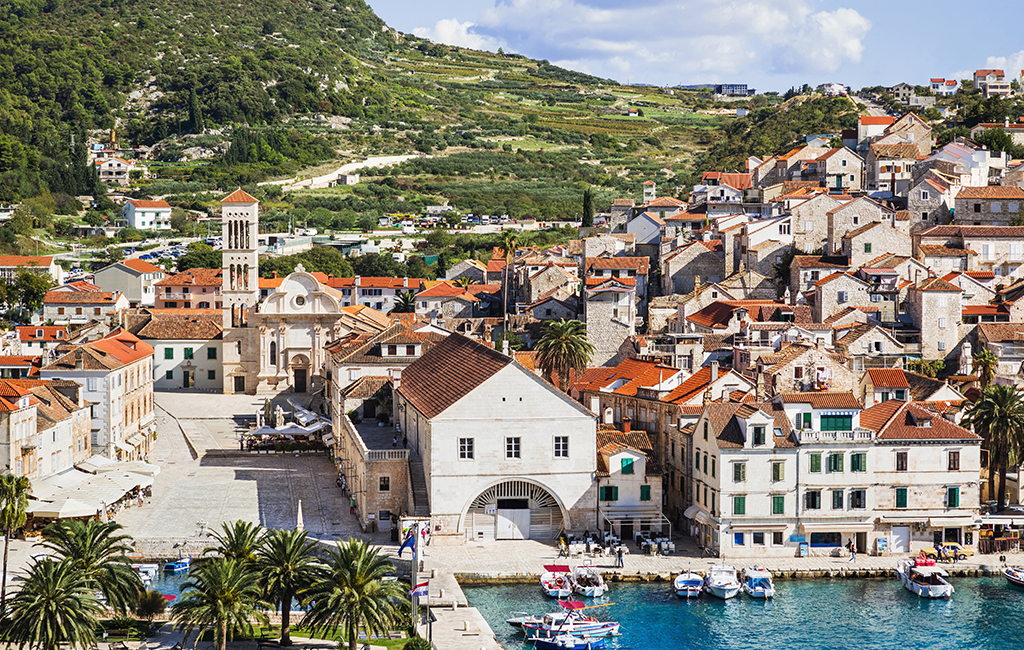
August: The Island of Hvar
Because Some Like it Hot
Hvar is an island of superlatives.
The sunniest island in Croatia; the most luxurious island in Croatia; and quite possibly the best-known island in Croatia.
Both Condé Nast Traveler and Travel + Leisure routinely rank Hvar among the most beautiful islands in the world, and it has long-been a favorite destination for superyachts and celebrities. Even Beyoncé and Jay-Z have been spotted on the island’s pebbled shores – and who can blame them? There is no denying Hvar’s incomparable allure.
Hvar Town cradles a turquoise harbor, where boats big and small clamor for moorings. Around it, a palm-lined promenade hosts swanky waterfront cafés and chic seafood restaurants, their patrons sipping champagne behind mirrored frames. From the Riva, the town extends inwards and upwards, past a central plaza and baroque cathedral, up the hill to a Venetian fortress; the winding alleys which lead there home to posh boutiques and trendy restaurants. Sprinkled throughout are the lively bars and lounges the island has become known for. Beyond Hvar Town, visitors will find a rural interior made up of vast fields of lavender, sloping vineyards, and ancient olive groves.
But Hvar in August? Isn’t it hot?? Isn’t it crowded???
Yes, yes, and yes…
But if you’re looking to experience Hvar at its most vivacious, its most fervent, its most Hvar, then this is the time to come!
The summer capital of Croatian nightlife, Hvar is home to a bevy of nightspots, from chilled out beach bars to upscale nightclubs. DJs spin in open-air discos and mixologists concoct top-shelf cocktails, while VIPs let loose behind velvet ropes. Parties start in late afternoon and gain intensity as the sun sets, sometimes moving to private yachts in the wee hours. Hvar’s legendary nightlife attracted such a crowd that at one point, the island seemed in danger of losing its savoir vivre to the boisterous party scene. However, restrictions put in place by local authorities and the opening of a new 5-star property have cemented Hvar’s position as a destination for the sophisticated and elite. This was further aided by the relocation of Hvar’s most famous club, Carpe Diem, to an island just off shore. There, the party rages all night long, fueling Hvar’s image as a leading party destination while preserving the relaxed glamour of the town center.
For now, the action and the elegance co-exist in perfect harmony, both reaching their peak when temperatures are hottest. So, yes, visit in August, because there’s simply no substitute for summer in Hvar.
Learn more about the island of Hvar here.
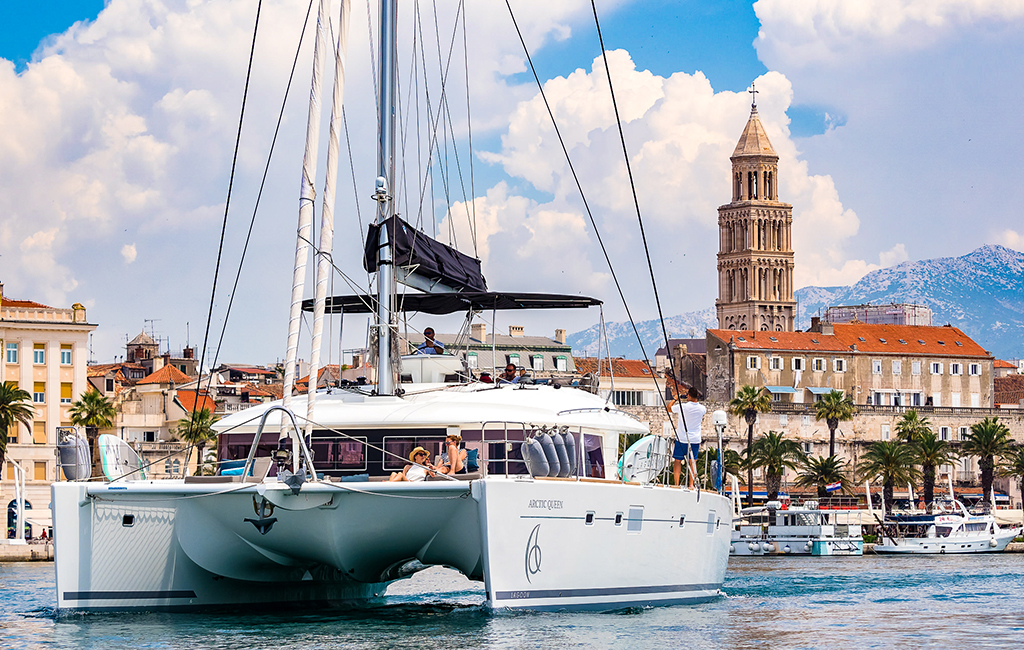
September: Split & Sailing
Seas the Day in Central Dalmatia
Croatian summers stretch well into September, marked by warm balmy days and cloudless skies that meet the horizon in a seemingly endless expanse of blue. You might not even notice that August had ended, be it not for the thinning of crowds as families head home and children back to school. Falling comfortably between the buzz of summer and hush of winter, September marks the sweet spot for travel to Croatia. It’s a fantastic time to visit pretty much anywhere in the country, but is especially perfect for an island-hopping escape.
Home to 1,244 islands, islets, rocks, and reefs, Croatia practically begs to be discovered by boat. It should come as no surprise then that the country is a major hub for nautical tourism, home to roughly 40% of the world’s yacht charter fleet. With the largest selection of private charter options in the world, there is a boat available to suit every taste, from budget friendly bareboats to luxurious superyachts.
Split serves as the ideal jumping off point from which to begin a multi-island itinerary; but don’t just visit the airport – this coastal metropolis is a worthy destination in its own right!
Croatia’s second city is brimming with historical sights, cultural attractions, lively beaches, and fashionable restaurants. At the heart of the city lies its jewel: an ancient palace constructed as a seaside retirement home for Roman Emperor Diocletian more than 17 centuries ago. A UNESCO World Heritage site, the eight-acre complex functions as a city within a city, home to roughly 3,000 residents and more than 200 buildings, including a smattering of charming boutique hotels. It is this unique tangle of old and new, the juxtaposition of contemporary life taking place among ancient ruins, that makes Split one of Croatia’s most compelling cities.
When you’ve had your fill of Split’s bustle, set sail to the deserted coves and sleepy villages of Central Dalmatia’s islands. Life on board is laid back; an easy routine of refreshing swims and long lunches set to the soundtrack of gentle lapping of waves. In the evenings, drop anchor and meander the seaside fishing villages and medieval fortress towns which dot the islands’ coasts and enjoy dinner at a local konoba.
The islands of Šolta, Brač, Vis, and Hvar are all easily visited on a round trip charter from Split. If sailing one-way from Split to Dubrovnik, the islands of Korčula, Mljet, Šipan, and Lopud also join the group. Each island has its own distinct personality and charm, and each is beautiful in its uniqueness.
But regardless of which islands you choose to visit, this we can tell you for sure: there is absolutely no better way to spend September in Croatia than lazing atop the sundeck of your own private yacht!
Read about our Concierge’s experience sailing in Dalmatia here.
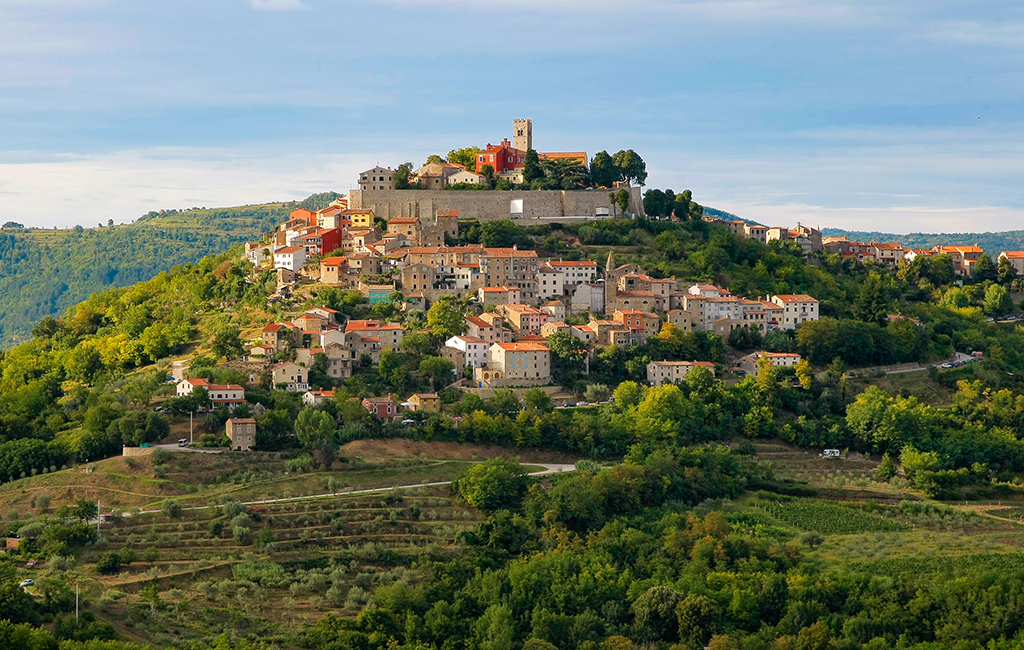
October: The Region of Istria
Gourmet delights in Croatia’s Truffle Country
Paper-thin slices of dry-cured prosciutto accompanied by ripe tangy cheeses, handmade pasta topped with freshly shaved truffles, and warm crusty bread dipped in mineral rich olive oil, all washed down with a ruby red glass of local wine.
Although it may sound like lunch at a Tuscan farmhouse, this mouthwatering meal is more often on the menu in Istria, the heart-shaped region in Croatia’s north-west.
Beautiful, arcadian Istria, with undulating hills topped by medieval villages, and a sparkling coastline dotted by candy-colored fishing towns. It’s not a secret, exactly, but it does seem to be off the radar of most international travelers – a shame, as it is perhaps the most underrated foodie destination in all of Europe.
This epicurean paradise is located at the crossroads of empires, so its culture and cuisine have long been influenced by the many powers that have occupied its land; from the Romans, to the Venetians, to the Ottomans, and the Habsburgs. For a brief time, between world wars, it was even part of Italy, and still today the region is bilingual. Istria has a microclimate ideal for cultivating grapes, olives, and figs, and fertile meadows which blossom with wild asparagus in spring. The clear, deep waters of the Adriatic keep fishermen’s nets full, and the dense forests of the interior are home to wild game.
But of all Istria’s agricultural blessings, the greatest treasure bestowed upon it is the truffle.
This rare delicacy can be found hidden in the moist soil of the Motovun forest, uncovered with the help of carefully trained dogs. Truffles were first found in Istria more than half a century ago, but did not gain notoriety until 1999 when truffle hunter Giancarlo Zigante and his faithful dog, Diana, uncovered a 1.3kg (2.9lbs) truffle, the largest ever found at that time. It earned Zigante a place in the Guinness Book of World Records and put Istria on the map as a premier location for scouting these precious tubers.
Today, visitors to Istria can enjoy embarking on truffle hunts of their own, joining a guide and trained dogs and sampling their findings afterward. It’s a fun way to spend an afternoon hiking, learning, and better yet, snacking. Truffle hunts are offered any season as various types of black truffle grow year-round, but it is only autumn when the illustrious white truffle can be found. The most pungent, flavorful, and highly-valued of all truffles, the white truffle, or Tuber Magnatum Pico, ripens only between September and January.
So, as Autumn is the season of white truffles, October is the month of truffle-themed celebrations. There’s Zigante Truffle Days which takes place in Livade from mid-September to mid-November, Tuber(food) Fest, also in the town of Livade, which takes place over a weekend in late October, and the Teran and Truffle Festival which is a single day event held in the picturesque hilltop town of Motovun. All three of these festivals can easily be experienced during a single late October journey.
Where is the best home base for exploring the region? That would be Rovinj, a picturesque fishing port with Venetian architecture and several luxurious hotels roughly an hour away from the truffle-filled forests of the hinterland. It’s the perfect place to rest your head and your belly after a food filled excursion.
Learn the Top 5 Reasons why your next trip should be to Istria here.
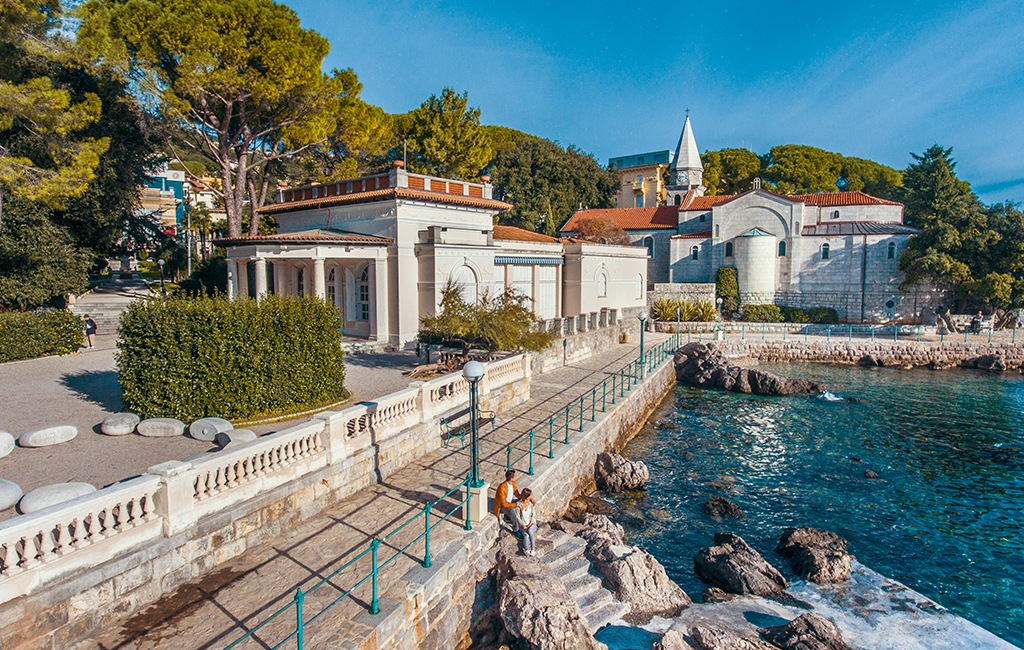
November: The Opatija Riviera
Pampering in Croatia’s Wellness Oasis
It was the ancient Romans who first traveled for pleasure, utilizing their wealth and vast systems of roadways to explore the lands they had conquered. The dark ages brought about a prompt end to leisure travel, but over time it was reintroduced in various forms, from religious pilgrimages and Tudor era progresses to the grand European tours made famous by artists and poets. A century later, it was the aristocracy of the Austro-Hungarian empire that embraced health retreats, the distant cousin of today’s beach holiday, and a precursor to medical tourism.
The most visited seaside resort of the Austro-Hungarian elite was the Opatija Riviera, a 30km stretch of land nestled between the wooded slopes of Mount Ucka and the rocky coastline of the Kvarner Gulf. Nicknamed “Vienna by the sea” due to its handsome Belle Époque architecture, Opatija is the cradle of tourism in Croatia.
The evolution of Opatija from humble fishing village to glamorous health resort began with Iginio Scarpa, a wealthy patrician from Rijeka, who in 1844 built the magnificent Villa Angiolina overlooking the sea. Both influential and well-connected, Scarpa’s guests included Austrian empress Maria Anna, Croatian ban Josip Jelačić, and botanist Heinrich Noë, as well as some of the greatest medical authorities of the time. All were taken by Opatija’s natural charms; lush vegetation, humid air, saline rich sea water, and a unique microclimate which guarantees mild winters. The area offered the ideal ingredients for therapeutic and restorative travel, elements central to the very idea of vacationing at that time. The construction of several luxury hotels, the picturesque Lungomare seaside promenade, and a direct railway line from Vienna to nearby Rijeka cemented Opatija’s reputation as an elegant spa town, and in 1889 it officially received the title of “Kurort” or health resort.
Today, Opatija continues its tradition as a center for wellness, attracting visitors seeking to relax and rejuvenate at its numerous spas, enjoying unique treatments and therapies. Visit in November to recharge your batteries before the holiday rush, and to take advantage of favorable off-season rates. Those looking for more comprehensive options may also wish to explore Opatija’s range of clinics, specialized hospitals, dental practices, and wellness centers.
View an autumn itinerary which includes Opatija here.
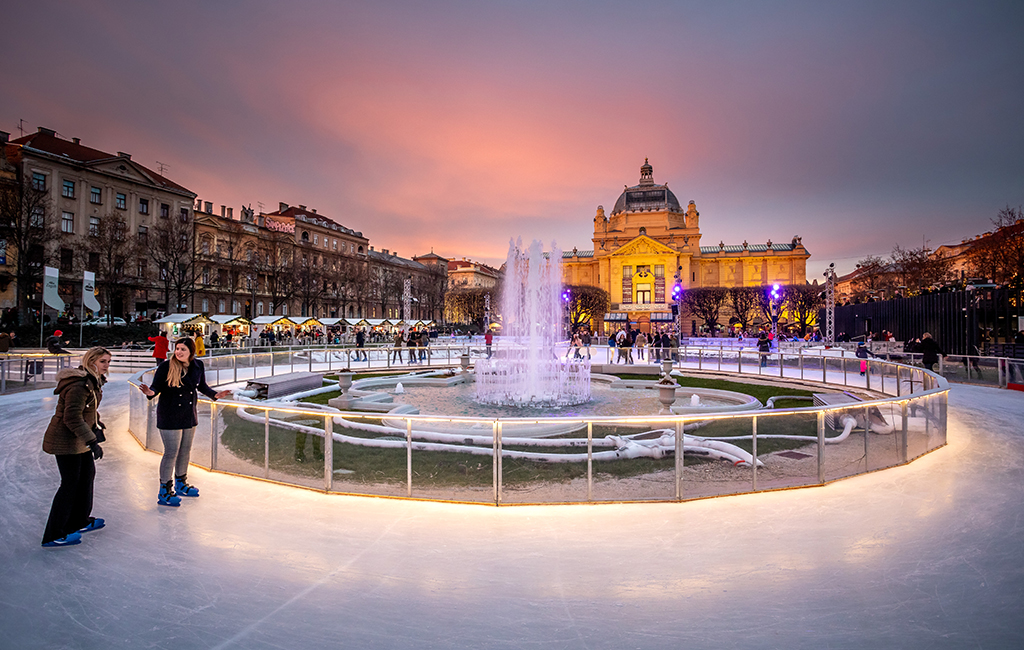
December: Zagreb
Europe’s Most Magical Christmas Market
Step aside Germany, there’s a new king of Christmas and it’s the Croatian capital!
Known as the “City with a million hearts,” Zagreb is Croatia’s largest city, home to roughly a quarter of the country’s population… And heart it certainly has! This dynamic metropolis is bursting with art, culture, and a vibe all its own. Zagreb’s energy is an eclectic mix of European sensibilities – a blend of buttoned-up Austro-Hungarian sophistication and laid-back Mediterranean charm. With more than 50 museums, Zagreb has more per capita than any other city in the world. It also has an active café culture, with over 4,500 cafés, bistros, and restaurants. That is equal to a ratio of 1 café per every 175 inhabitants! Add to that elegant hotels, bespoke shopping, beautifully manicured parks, and one of Europe’s best Christmas Markets, and it’s easy to see why so many Croatians choose to make Zagreb their home.
Yes, you read that correctly; Zagreb is home to one of Europe’s best Christmas Markets! In fact, Advent in Zagreb had the honor of being crowned “Best Christmas Market” by European Best Destinations three years in a row, the maximum number of wins allowed! Quite an accomplishment for a city still largely undiscovered by overseas visitors.
As you might have guessed, this isn’t your average Christmas Market. Advent in Zagreb is made up of more than 25 individual open-air Christmas Markets spread throughout the city, each with its own unique theme and atmosphere. Some of the markets resemble the traditional aesthetic found across German-speaking Europe, with chalet-like stalls selling handmade trinkets and warm mulled wine. However other markets take a more avant-garde approach, with spirited entertainment such as DJs and live concerts, interactive exhibitions, international cuisine, and even a tram driven by Jolly St. Nick himself! It all comes together to form a truly unique Christmas experience, while still maintaining the family-friendly Hallmark movie cheer of the holiday season.
Christmas festivities typically begin on the Saturday before the first Sunday of Advent (usually Late November) and run through the first week of January, making December in Zagreb the most magical month of the year. Just two hours by car from the Slovenian capital, Ljubljana, Zagreb makes a wonderful starting point from which to embark on a European Christmas Market tour.
Learn more about Advent in Zagreb here.
 About the Author:
About the Author: